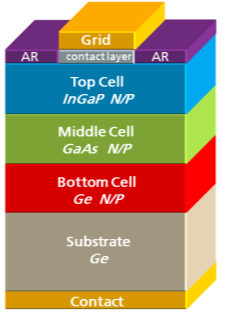NANOcoat
Effective coating for next generation solar cells
| Business | Time | Prime Contractor | Client |
|---|---|---|---|
| Industry | January 2018 October 2019 |
RINA Consulting | European Space Agency |
Challenge
An important field to improve solar cell efficiency is the optimization of the antireflection coating (ARC) to allow more light to be converted. In this context, the main objective of the NanoCoat project was to develop a set of innovations based on functional surface coatings aimed at increasing the power conversion efficiency of present and next generation multi-junction (III – V) solar cells (MJSC) for space applications. An increase in power conversion efficiency of at least 0.5% was expected for standard and reduced thickness MJSC considered. This goal was pursued by engineering for both of them a broadband antireflection coating (wavelength from 250 to 1800 nm), better surface and edge passivation (front and rear) and more efficient electrical contacts (front and rear).
For next generation MJSC with reduced Ge substrate thickness (≤ 80 μm) and hence higher specific power, W/g, the Nanocoat project will introduce ad hoc photonic structures capable of increasing the optical path of IR photons with respect to the standard flat metallisation approach. Such an ambitious objective is of outmost importance as it provides for the potential for a sharp rise in the capability of harvesting energy in space, through a more efficient exploitation of the solar spectrum.
Approach
As project coordinator, RINA was commissioned to manage the full project cycle and was in charge of the project management (including quality and risk management). We provided system engineering services, we performed testing and roadmapping activities, and we conducted LCA studies.
Innovative materials were explored: wide band gap materials as components of a multilayer broad-band ARC and passivation layers for the front of the MJSC; unconventional conductors for front and rear electrical contacts; back surface passivation layers and photonic structures to increase the optical path of IR photons in thin TJSC.
Sputtering is the reference thin film deposition technique since it is developed in industrial settings, nevertheless less conventional techniques (Pulsed laser deposition and pulsed electron deposition), were tested for their unique ability to deposit highly adherent, dense and low roughness coatings of a variety of materials at low substrate temperature.
Two new antireflection coating designs demonstrated to be superior with respect to standard CESI antireflection coating design: a triple-layer structure and a gradient-index structure. Both structures are fabricated on top of 2x2 cm2 solar cells, in order to assess their optical and electrical performance before the scale-up towards 4x8 cm2 solar cells.
In the new ARC designs the surface and edge passivation WEre provided by the conformal deposition of Nb2O5 (both for the triple-layer and the gradient-index ARC) a wide band-gap transitional metal oxides. The pulsed laser deposition technique ensureD that both the surface and the edge of the solar cell substrates were covered with high-quality films during the deposition process.
High quality copper deposited by sputtering, as an inexpensive alternative to the current gold-capped silver for the front and back metallic contacts, was investigated.
Conclusion
The triple-layer ARC structure had its best optical response in the 400-900 nm spectral range whereas the gradient-index ARC provided an overall reduction of the total reflectance. The measurements on CTJ30 CESI solar cells under a continuous light dual source solar simulator showed a significant increase in the electrical performance of the device coated with the two new ARC structures with respect to the standard.
The efficiency increase was achieved. The triple layer ARC was upgraded for standard 4x8 cm2 solar cells. Several devices were successfully tested showing no degradation of the electrical parameters after irradiation, thermal shock and humidity & temperature tests.
Subcontractors
1. CESI S.p.A. 2. IIT 3. IMEM-CNR